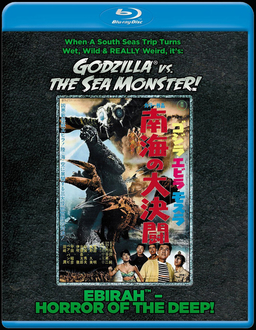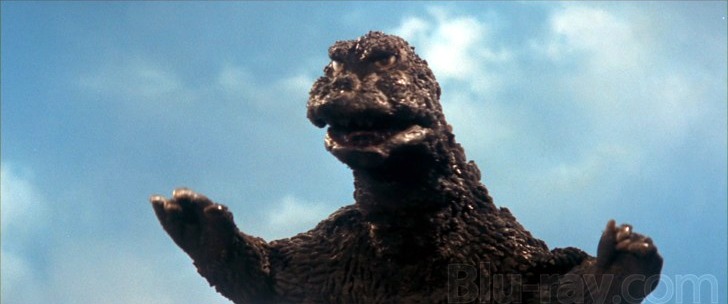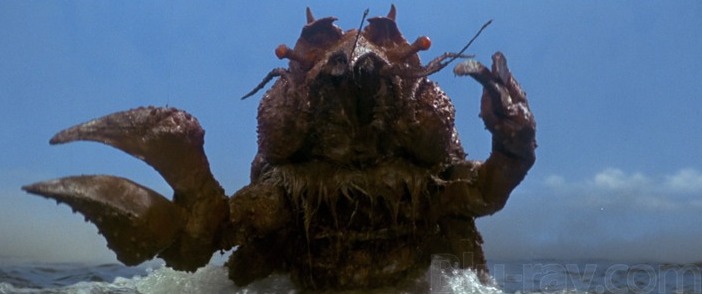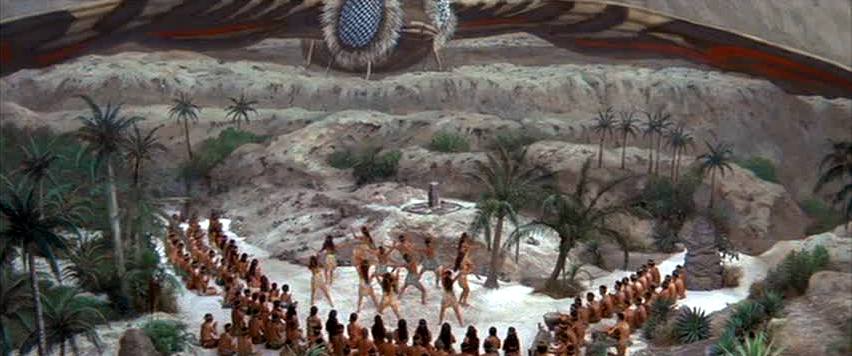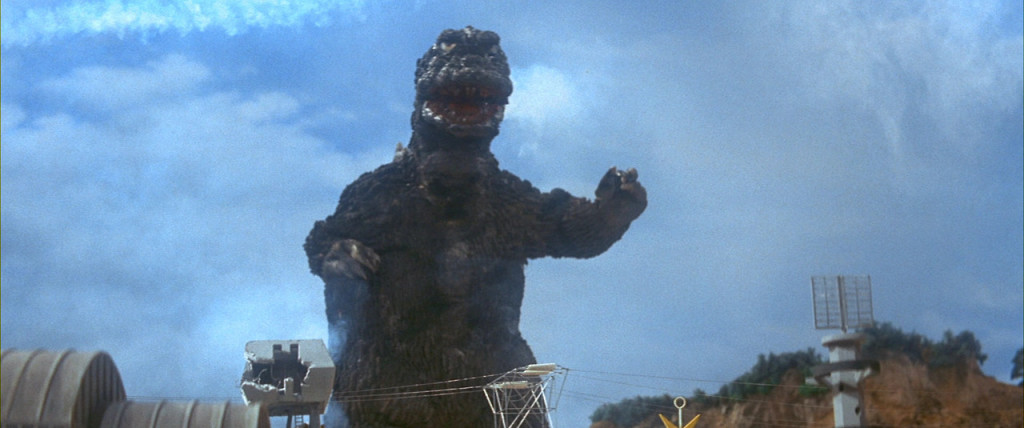The Godzilla Blu-ray Flood: Ebirah, Horror of the Deep (Godzilla vs. The Sea Monster)
After a few years fighting battles among the cities of Japan and facing the hapless measures of the Japanese Self-Defense force, Godzilla got to go on a tropical island vacation and enjoy broiled seafood. The results were an entertaining variation on the classic Godzilla formula known as Ebirah, Horror of the Deep. Or maybe Godzilla vs. The Sea Monster. It depends on how strict you are about Toho Studio’s official English titles.
The arrival of the new US Godzilla triggered a flood of Japanese Godzilla films to Blu-ray, with eleven hitting hi-def on the same day, spread across seven releases. The oldest film on the slate is 1966’s Ebirah, Horror of the Deep, arriving courtesy of small label Kraken Releasing, a successor to ADV Films. You may know Ebirah better under its original U.S. television broadcast title, Godzilla versus the Sea Monster, with “vs.” spelled out for reasons best left mysterious. This Blu-ray is the first stateside release to have the official English title on the cover, although the movie’s title card reads Godzilla vs. The Sea Monster, no longer spelling out “vs.” Reasons more mysterious.
A brief backdrop to this odd G-film: In 1965, Toho Studios made a deal with U.S. animation company Rankin/Bass to co-finance a live-action movie featuring the return of Toho’s version of King Kong. The show would tie into a Rankin/Bass Saturday morning animated series, The King Kong Show. Toho’s writers created a script titled Operation Robinson Crusoe, but Rankin/Bass passed on the idea. The King Kong film eventually emerged in 1967 as King Kong Escapes. But Toho chose to recycle the Operation Robinson Crusoe script as a Godzilla project.
Toho also decided to make it a lower budgeted Godzilla film than the previous entries and placed a different creative team on it. Crime movie director Jun Fukuda replaced Toho’s A-list monster and science-fiction specialist Ishiro Honda. Although Toho Special Effects Department head Eiji Tsubaraya received credit for the VFX direction, his assistant Teisho Arikawa handled most of the hands-on work. Regular Godzilla composer Akira Ifukube was also absent, although his replacement, Masuro Sato, certainly was no B-lister; he was director Akira Kurosawa’s favorite composer and previously scored the second Godzilla film, Godzilla Raids Again (1955). Nonetheless, going with Sato — along with Fukuda and Arikawa — definitely gives the sense that Toho viewed Ebirah as a scaled-down production compared to the Honda-Tsubaraya-Ifukube epics of the previous years.
Ebirah often divides Godzilla fans, although not as sharply as oddities like Godzilla vs. Hedorah (1971) or Godzilla: Final Wars (2004). For many fans who grew up with G-films on television, Ebirah disappointed: it brought the monster action in too late, contained no urban destruction or super-weapons, and Godzilla’s kaiju opponent was a less-than-impressive crustacean.
But the movie will surprise the adult fans who can overcome their childhood disappointment and discover how good a story it has. Ebirah snaps away from the science-fiction plots of the previous series entries and instead crafts a tropical adventure story with an appealing cast and fast-moving events that use the monsters as elements in a larger fabric. Although it isn’t a great Godzilla film, it’s a very good adventure film and at least a partially good Godzilla film. Viewed as a change of pace, Ebirah, Horror of the Deep succeeds.
The monsters do not set the story in motion, which is one of the unusual aspects. Instead, humans take the center stage — and they aren’t a dull bunch either, since they are designed as the leads in an action story rather than supporting figures for a SF tale about giant monsters. It’s unusual for a Godzilla film to have such vibrant characters; usually only villains receive such parts, but this is another element that makes the movie stand out for older viewers.
Our protagonist — or at least the one who catalyzes the story — is Ryota (Toru Watanabe), a young man with an obsession about finding his brother Yata (Toru Ibuki) after his boat vanishes in the South Seas. Ryota seems a bit touched in the head the whole movie, but everything turns out fine in the end so nobody holds him accountable for repeatedly almost getting everyone killed.
Ryota starts off his nutty escapades when he cuts loose a yacht from a harbor and sets it adrift in the sea while three other people are onboard: two youths Ryota bumped into at a dance marathon, and the ostensible owner of the yacht, Yoshimura (Akira Takarada). However, Yoshimura has no idea how to sail the yacht, won’t let anybody touch his attaché case, and gets nervous every time news reports pop up on the radio about a thief who robbed the offices of a shipping company. The script thankfully allows the other characters to figure out soon that Yoshimura is indeed the thief so they don’t look like bumbling fools.
After a few weeks at sea with the food running out — and no doubt the other passengers wondering how best to drown or keelhaul Ryota for sticking them in this mess — the good ship Yahlen reaches Devil Island, where its guardian super-lobster Ebirah cracks the yacht into splinters and strands the three kids and the thief on shore. Now the fun starts.
Devil Island harbors the headquarters of the evil paramilitary organization, the Red Bamboo. Although designed after SPECTRE from the James Bond movies, the Red Bamboo might as well wave the flag of mainland China for all the subtlety they project of Japan’s fears of the nuclear giant next door. The Red Bamboo has no specific plan about which we ever learn, but the facilities on Devil Island contain a heavy water factory capable of creating hydrogen bombs. That was a scary concept for the Japanese at the time. With North Korea’s continued nuclear blustering, it’s still scary.
James Bond was a sensation in Japan, and Ebirah shows heavy 007 influences. The Red Bamboo is an obvious imitation of SPECTRE (plus Chinese analogy) with uniformed thugs, colorful high-tech headquarters, nuclear terrorist ambitions (I think), and a head enforcer with a physical deformity. Instead of sending a James Bond figure to save the day, Ebirah sends Godzilla. Godzilla is tall, dark, and has a great sense of style, and so isn’t as far removed from James Bond as you might think. Godzilla even flirts with the film’s native girl heroine, although this is probably a leftover from the King Kong version of the script.
The Bond movie that Ebirah borrows from the most is Dr. No: both occur on tropical islands where a villainous cabal runs a secret laboratory and keeps intruders away with the threat of a monster. But where Dr. No only has a tractor and flame-thrower pretending to be a dragon, Ebirah has a genuine monster, a ginormous carnivorous lobster that kills anyone attempting to land on or escape from the island.
Once our gaggle of mismatched heroes are shipwrecked, the film turns into a chase-and-escape tale, as the three kids, the good-hearted thief, and a freed native girl (Kumi Mizuno) try to elude the clutches of the trigger-happy Red Bamboo soldiers and their captain (Akihiko Hirata) while finding a way to escape the island without Ebirah turning them into the sushi special. Ryota is still dizzy with his fantasies about saving his brother, whom he learns is on Infant Island where the natives are trying to wake up Mothra to come rescue the ones the Red Bamboo have enslaved.
Godzilla eventually enters the story: while hiding from the soldiers who are randomly firing guns everywhere they go, the castaways discover the famous monster hibernating at the bottom of a cavern. Why is Godzilla asleep buried among rubble? Probably because this is another leftover of the King Kong script. When the kids hatch a plan to wake up Godzilla using lightning — thus giving the Red Bamboo a much larger problem than trying to track down some pesky kids — we have yet another King Kong leftover: in King Kong vs. Godzilla, lightning energized Kong but repelled Godzilla.
The film was exciting before Godzilla’s awakening, which is no mean feat considering that this is a Godzilla film, but it ramps up fast once the heroes jolt the Big G from sleep and the monster makes life tough for the Red Bamboo and tussles with the local sea life.
A confluence of events occurs puts the movie on a track for its exciting conclusion: rescue the enslaved islanders, let Godzilla trash the Red Bamboo base and broil Ebirah, disarm a hydrogen bomb about to go off on the base, and hope that Mothra wakes up and arrives with an exit from the island before everybody goes ka-boom!
Even with all this extra action, the main monster’s belated entrance, the human-dominated story, and a cast of characters you can easily tell apart (aside from the two interchangeable guys from the dance contest, who function like a single part), this is still a genuine Godzilla film. Godzilla works as co-hero and an adversary to the protagonists: the monster turns its attention on the Red Bamboo and Ebirah because they’re the ones who attack and bother it; but our heroes need to worry about not getting squashed in the process.
In the very end, Godzilla refuses to play nice and makes an effort to atomic-roast Mothra when the natives and the castaways try to board a basket Mothra is carrying. Godzilla doesn’t discriminate, but at least most of the time the monster is after the bad guys. With the clock ticking toward the island going up in mushroom cloud, the escapees in the basket shout at Godzilla to get out into the water — apparently thinking the Big G understands Japanese or something. This is a nice touch: the monster almost killed them trying to blast Mothra, but it did wipe out the Red Bamboo base and that annoying lobster … so Godzilla’s an okay bloke.
The Godzilla-centered effects scenes are generally entertaining. The fights with Ebirah will never go down among Godzilla’s most famous battles, but they have amusement value. It’s a touch of ludicrous fun to see the two monsters batter a rock between them like a badminton game, with Godzilla executing a nice header. Godzilla also pulls two great finishing moves on the sappy lobster in the final fight and gives Ebirah the Godzilla equivalent of “the bird.” All the personality that Godzilla developed over the last three films is strong here; the Big G just has a less interesting opponent to face and fewer models to knock over.
The reduced budget for Ebirah, Horror of the Deep doesn’t show often on screen because the island setting hides that VFX handler Teisho Arikawa had fewer funds to build miniatures. But what he does manage is often excellent. The Red Bamboo base stands in for the city that gets the Godzilla stomping treatment, and the details on it are impressive and match the full-sized sets. Arikawa also uses clever low angles and seamless composite shots of the cast with Godzilla in the background that remind us, even without skyscrapers present, how enormous this monster is. Mothra receives a similar treatment: when the giant moth touches down on Devil Island during the finale and the refugees dash toward it, the composited shot is jaw-dropping for how it displays the immensity of Mothra’s wingspan. Mothra hasn’t appeared so large since its original movie in 1961.
The special effects highlight is when the Red Bamboo scrambles attack jets to assault Godzilla. Arikawa treats us to a few minutes of spectacular firepower and sweeping camera movements as the jets unleash their payload and Godzilla takes them down with some fast maneuvering. The sequence feels like another survivor of the King Kong version of the script: the execution resembles the bi-plane attack on Kong atop the Empire State Building. Even some of the swooping POV shots appear similar to the photography from that famous scene. The set-piece opens with an odd and inappropriate piece of surf-rock style music (not credited to Sato), which is the only down note in an otherwise fine sequence.
Ebirah is nobody’s favorite monster; its design is too uninspired and similar to a familiar animal. As a Godzilla adversary, it adequately fills the role and gets out after its two fights. When placed against the humans, however, Ebirah enlarges into something horrifying; this is a rare monster that pays attention to people … and eats them! When Ebirah’s claw starts to rise out of the ocean behind swimmers in the water, the effect is menacing and creates a sense of how enormous the creature is compared to people. Sato provides a eerie guitar effect for these moments.
There’s a bonus monster in the cast: a giant condor that pesters Godzilla for a minute before it gets unceremoniously charred. Not one of the VFX highlights. It actually works better as stock footage in All Monsters Attack where lack of context makes it seem less out of nowhere.
Among the cast, Akira Takarada as the Good Thief Yoshimura and Akihiko Hirata as the captain of the Dragon Guard are the standouts. Both men have a long history with Godzilla, going back to leading roles in the 1954 original. Takarada is all roguish charm as the thief who turns into just the right sort of hero who can outwit the Red Bamboo with stealth tactics and a skeleton key. Hirata plays a classic Bond henchman type with a dragon eye patch and grinning snarl. Both actors were clearly having a great time with their roles.
Comparing this movie to the Heisei and Millennium films released to Blu-ray the same day shows how much more visually appealing the Showa era movies are in general. This was a golden age of Japanese cinema, and even in a lower-budgeted monster adventure film, the talent pool at Toho Studios of the day shines. Ebirah, Horror of the Deep is a color burst, with gorgeous oranges and reds popping out of the frame in almost every shot. The extensive sets for the Red Bamboo base are also exciting, recalling the work of Ken Adam on the James Bond films — on purpose, certainly.
The experiment with the scaled-down island adventure was enough of a success that Toho repeated it next year, using essentially the same creative personnel, with Son of Godzilla.
When it reached the U.S., Ebirah skipped theatrical release, the first Godzilla film to go this route — and unfortunately not the last. The Walter Reade Organization, which previously distributed Ghidorah, The Three-Headed Monster (1964) to theaters, shipped the new film straight to syndicated television. (Promotional materials from the distributor describe Godzilla as “the heroic-titan-ape.” Did they even know what they were selling?) Walter Reade’s title change to Godzilla versus the Sea Monster makes marketing sense, since it informs viewers that this indeed is a Godzilla film, and that Godzilla fights a sea monster. Subsequent video releases retained the TV name for convenient shelving purposes. But the title Ebirah, Horror of the Deep shouts “classic Toho” in its strangeness; and since the film marks an abrupt switch from the style of the previous films, putting the title focus on a tropical ocean beastie has logic to it even if Ebirah itself isn’t worth owning it. The Japanese title, Nankai no Daiketto, which translates loosely as “Big Duel in the South Seas,” is the most appealing of all. If I could retitle the film for a new English release, it would be Godzilla: Battle in the South Seas. But nobody asked me.
The Walter Reade version has a few changes. A new opening made from editing together pieces of the wreck of the Yahlen later in the film is supposed to show Ryota’s brother Yata in the shipwreck that stranded him; this replaces cut scenes of Ryota seeking help finding his brother from the government and later from a newspaper. The dub was another superb job from Titra Sound in New York. However, the Walter Reade Godzilla versus the Sea Monster is now rare, since the dub on the current Blu-ray, as well as the earlier Sony DVD, is the “international” dub that Toho contracted from Frontier Enterprises.
Kraken’s Blu-ray looks and sounds fantastic, although like the other G-films from the label there are no bonus features aside from the Japanese trailer. (Great trailer, however. Nice use of “Night on Bald Mountain.”) Kraken’s transfer is clean, crisp, and captures the bold colors of the movie in its original Tohoscope.
Ryan Harvey is one of the original bloggers for Black Gate, starting in 2008. He received the Writers of the Future Award for his short story “An Acolyte of Black Spires,” and his stories “The Sorrowless Thief” and “Stand at Dubun-Geb” are available in Black Gate online fiction. A further Ahn-Tarqa adventure, “Farewell to Tyrn”, is currently available as an e-book. Ryan lives in Los Angeles. Occasionally, people ask him to talk about Edgar Rice Burroughs or Godzilla in interviews.
